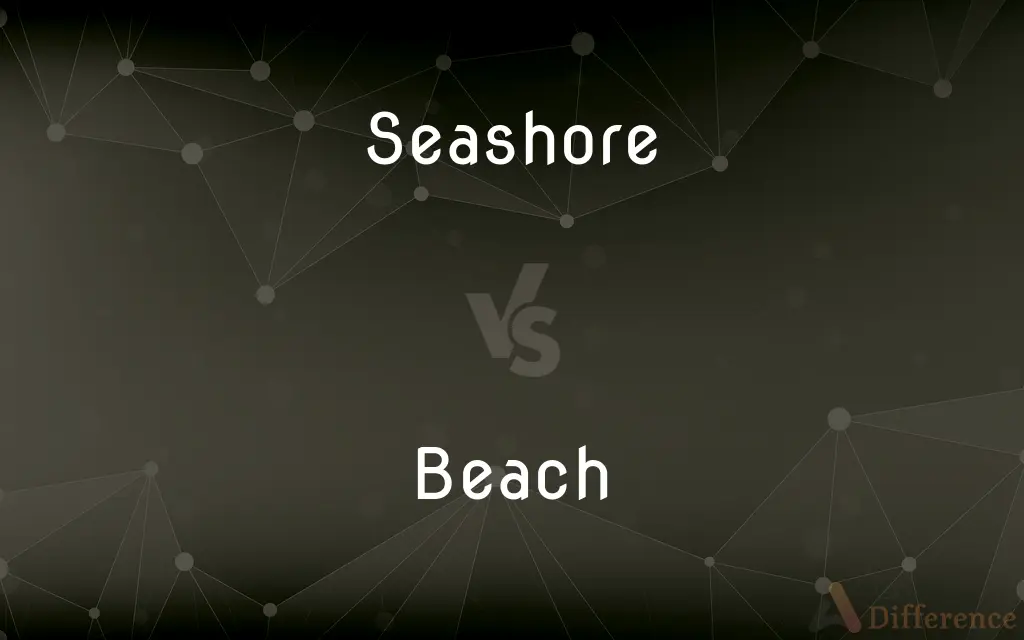Seashore vs. Beach — What's the Difference?
By Maham Liaqat & Fiza Rafique — Updated on March 19, 2024
Seashore encompasses the broader coastal area including water, land, and ecosystem; beach specifically refers to sandy or pebbly shores by water.

Difference Between Seashore and Beach
Table of Contents
ADVERTISEMENT
Key Differences
Seashores represent the wider interface between land and sea, including water, landforms, and the ecosystem. They extend beyond the sandy or pebbly areas, encompassing cliffs, rocks, and flora and fauna. Beaches, on the other hand, specifically refer to the sandy or pebbly stretches along the coastline, where the land meets the sea or ocean. These areas are characterized by their loose surface materials like sand, gravel, pebbles, and sometimes shells.
While seashores include a variety of landscapes and biological diversity, offering habitats for different marine and terrestrial species, beaches are primarily known for their recreational value. They are popular destinations for activities such as sunbathing, swimming, and picnicking. Seashores, with their broader ecological context, play a crucial role in coastal protection and biodiversity conservation.
Seashores often undergo dynamic changes due to tidal movements, erosion, and sediment deposition, affecting the entire coastal ecosystem. Beaches, however, are more visibly impacted by these processes, with noticeable changes in beach shape and size over time. The management and conservation efforts for seashores and beaches also differ, focusing on preserving the natural habitat and preventing erosion.
Tourism impacts seashores and beaches differently. While beaches attract visitors for leisure and entertainment, leading to developments like resorts and sports facilities, seashore areas may be protected zones, emphasizing conservation and sustainable tourism practices. The balance between accessibility and preservation is key in managing both seashores and beaches.
In terms of climate impact, seashores are studied for their role in carbon sequestration and as indicators of climate change, such as rising sea levels and increased storm intensity. Beaches are often at the frontline of these changes, experiencing erosion and habitat loss, which directly affects tourism and local economies.
ADVERTISEMENT
Comparison Chart
Definition
The interface between land and sea, including various landforms and ecosystems.
A narrow, gently sloping strip of land that borders a sea or ocean, typically covered with sand or pebbles.
Composition
Can include sandy or pebbly areas, cliffs, rocks, and vegetation.
Primarily composed of sand, gravel, pebbles, or shells.
Primary Use
Diverse, including ecological conservation, recreation, and scientific research.
Mainly for recreation, such as swimming, sunbathing, and sports.
Environmental Impact
Subject to erosion, sedimentation, and changes in biodiversity.
More visibly impacted by erosion, human activities, and climate change.
Conservation Efforts
Focus on preserving natural habitats, biodiversity, and maintaining ecological balance.
Often aimed at preventing erosion, managing tourist impact, and sustaining local economies.
Compare with Definitions
Seashore
Serves as a critical habitat for marine and terrestrial species.
The seashore ecosystem supports both aquatic and land-based food chains.
Beach
Faces issues like erosion and habitat loss due to climate change and human activity.
Erosion control measures have been implemented to protect the beach from vanishing.
Seashore
Features diverse landscapes like cliffs, rocks, and sandy stretches.
Rocky formations along the seashore provide nesting sites for seabirds.
Beach
Composed mainly of sand, pebbles, shells, and sometimes gravel.
The beach is known for its fine, white sand and calm waters.
Seashore
Subject to conservation efforts to protect natural habitats and biodiversity.
Conservation projects on the seashore focus on turtle nesting sites.
Beach
Often developed for tourism, with facilities like resorts and bars.
The once secluded beach now boasts several luxury resorts.
Seashore
Used for a variety of recreational activities, though with emphasis on natural beauty.
Families enjoy picnicking on the grassy areas of the seashore.
Beach
A sandy or pebbly shore by the sea or ocean.
The beach at Coral Bay is famous for its clear, turquoise waters.
Seashore
The area where land meets the sea, including water, landforms, and ecosystems.
The seashore at Dawn Beach is a habitat for various marine species.
Beach
A popular destination for swimming, sunbathing, and water sports.
Every summer, the beach becomes a hub for volleyball tournaments.
Seashore
Land by the sea.
Beach
A beach is a landform alongside a body of water which consists of loose particles. The particles composing a beach are typically made from rock, such as sand, gravel, shingle, pebbles, etc., or biological sources, such as mollusc shells or coralline algae.
Seashore
The coastal land bordering a sea or an ocean.
Beach
A pebbly or sandy shore, especially by the sea between high- and low-water marks
Fabulous sandy beaches
Seashore
The foreshore, the strip of land between low water and high water.
Beach
Run or haul up (a boat or ship) on to a beach
At the water's edge a rowing boat was beached
Seashore
The coast of the sea; the land that lies adjacent to the sea or ocean.
Beach
The shore of a body of water, especially when sandy or pebbly.
Seashore
All the ground between the ordinary high-water and low-water marks.
Beach
The sand or pebbles on a shore.
Seashore
The shore of a sea or ocean
Beach
The zone above the water line at a shore of a body of water, marked by an accumulation of sand, stone, or gravel that has been deposited by the tide or waves.
Beach
To run, haul, or bring ashore
Beached the rowboat in front of the cabin.
Hooked a big bluefish but was unable to beach it.
Beach
To cause (a whale or other sea animal) to be unable to swim free from a beach.
Beach
To run or be hauled ashore
We beached near the palm trees.
Beach
To be stranded on a beach. Used of sea animals.
Beach
The shore of a body of water, especially when sandy or pebbly.
Beach
A horizontal strip of land, usually sandy, adjoining water.
Beach
The loose pebbles of the seashore, especially worn by waves; shingle.
Beach
Synonym of gravel trap
Beach
(sports) A dry, dusty pitch or situation, as though playing on sand.
Beach
(intransitive) To run aground on a beach.
Beach
(transitive) To run (something) aground on a beach.
Beach
(of a vehicle) To run into an obstacle or rough or soft ground, so that the floor of the vehicle rests on the ground and the wheels cannot gain traction.
Beach
Pebbles, collectively; shingle.
Beach
The shore of the sea, or of a lake, which is washed by the waves; especially, a sandy or pebbly shore; the strand.
Beach
To run or drive (as a vessel or a boat) upon a beach; to strand; as, to beach a ship.
Beach
An area of sand sloping down to the water of a sea or lake
Beach
Land on a beach;
The ship beached near the port
Common Curiosities
What are the main conservation efforts for beaches?
Conservation efforts for beaches often focus on preventing erosion, managing tourist impacts, and protecting local wildlife.
What defines a seashore?
A seashore is the area where land meets the sea, encompassing various landforms, ecosystems, and the water itself.
How is a beach different from a seashore?
A beach is specifically the sandy or pebbly part of the coastline, whereas a seashore includes the broader coastal area with diverse landscapes and ecosystems.
Why are seashores important for the environment?
Seashores are vital for biodiversity, providing habitats for various species, and play a role in coastal protection and carbon sequestration.
Can a beach be part of a seashore?
Yes, beaches are part of seashores, representing the sandy or pebbly stretches along the coastline.
How does tourism affect seashores and beaches differently?
Tourism primarily impacts beaches through development and recreational use, while seashore areas might be protected for conservation and experience sustainable tourism.
Can seashores be found inland?
No, seashores are specifically the areas where land meets an ocean or sea, so they cannot be inland.
What activities are common on beaches?
Common activities on beaches include swimming, sunbathing, picnicking, and various water sports.
Are seashores affected by climate change?
Yes, seashores are significantly affected by climate change, including rising sea levels and increased storm intensity, impacting the entire coastal ecosystem.
How are beaches formed?
Beaches are formed through the accumulation of sand, pebbles, and other sediment, often brought by sea waves and currents.
Do all beaches have sand?
No, some beaches can be rocky, pebbly, or covered in shells rather than sand.
What is the difference in biodiversity between seashores and beaches?
Seashores have a broader and more diverse ecosystem, including marine, terrestrial, and avian species, whereas beaches have a narrower focus, primarily on species adapted to sandy or pebbly environments.
Share Your Discovery

Previous Comparison
Kana vs. Kanji
Next Comparison
Check vs. ReviewAuthor Spotlight
Written by
Maham LiaqatCo-written by
Fiza RafiqueFiza Rafique is a skilled content writer at AskDifference.com, where she meticulously refines and enhances written pieces. Drawing from her vast editorial expertise, Fiza ensures clarity, accuracy, and precision in every article. Passionate about language, she continually seeks to elevate the quality of content for readers worldwide.
















































